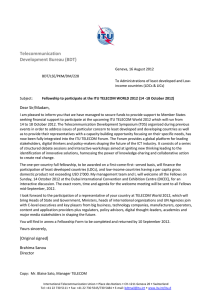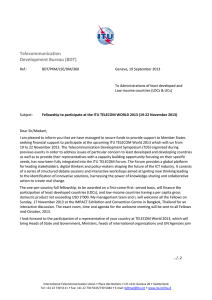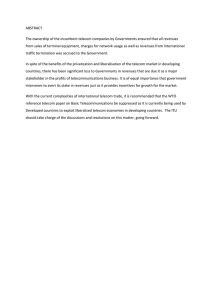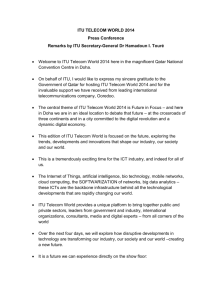International Interconnection
advertisement
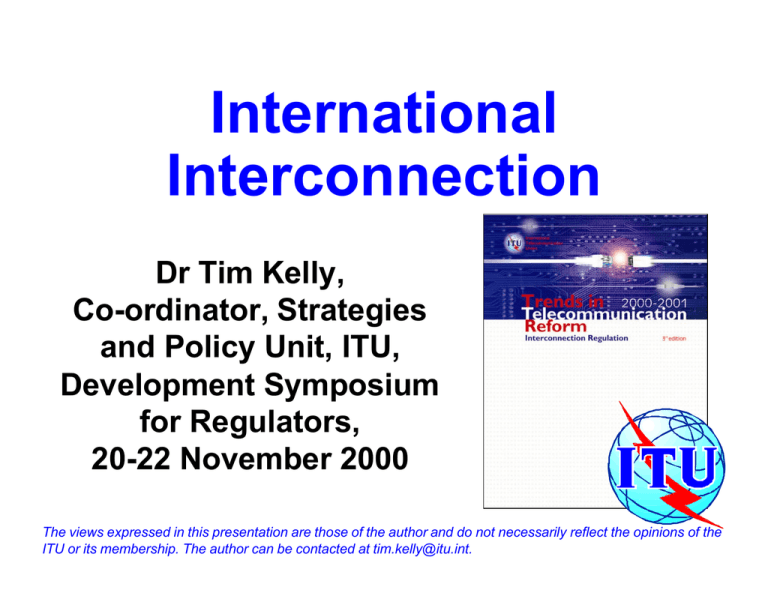
International Interconnection Dr Tim Kelly, Co-ordinator, Strategies and Policy Unit, ITU, Development Symposium for Regulators, 20-22 November 2000 The views expressed in this presentation are those of the author and do not necessarily reflect the opinions of the ITU or its membership. The author can be contacted at tim.kelly@itu.int. International Interconnection Trends in Telecom Reform, Chap 8 l Trends in international telecom traffic and prices l From the old world … ð The bilateral accounting rate system ð Accounting rate reform l … to the new world ð Cost-oriented, facilities-based interconnection ð Trading telecom minutes l Issues for regulators The International Telecom Traffic Roller-coaster Global international telephone calls Billions of minutes 18% 19% 18% 17% 101 94 86 17%17% 79 17% 16% 71 15% 15% 15% 15% 15% 15% 64 14% 13% 57 13% Annual change 12% 12% 12%12% 49 11% 11% 43 38 9% 8%8% 33 28 24 21 18 16 14 11 13 10 9 6 8 5 5 4 75 76 77 78 79 80 81 82 83 84 85 86 87 88 89 90 91 92 93 94 95 96 97 98 99 00 Source: ITU “Trends in Telecom Reform, 2000/01” The international call price squeeze Swiss call prices. US cents per minute. 74 58 58 Call to USA 43 28 Local call 7 5 5 4 4 4 4 95 96 97 98 99 00 Source: ITU “Trends in Telecom Reform, 2000/01” The accounting rate regime unravels l The bilateral accounting rate regime ð More than 100 years old ð Rates negotiated and accounts settled bilaterally ð Worked well in time of monopolies, state control and balanced traffic flows l As market liberalisation increases … ð Price imbalances and traffic imbalances grow ð Net settlements increase, creating incentives for operators receiving more traffic than they send to keep prices high l … pressure for a multilateral agreement grows ð WTO basic telecommunications agreement creates possibility for direct interconnection, but agreement avoids discussing accounting rates Accounting rates are falling; but not fast enough to avoid by-pass? 1.2 1 World Settlement rate trends, in SDRs 1.01 1.00 0.98 USA Asia-Pacific 0.95 0.91 0.87 0.8 Africa 0.85 0.64 0.6 0.4 LAC 0.81 0.67 0.58 0.45 0.49 0.40 0.37 0.35 0.31 0.27 0.2 0.47 0.25 0.49 0.42 0.23 0.37 0.20 0.60 0.54 0.54 0.39 0.39 0.32 0.29 0.15 0.14 0 1990 1991 1992 1993 1994 Source: ITU “Trends in Telecom Reform, 2000/01” 1995 1996 1997 1998 1999 2000 Accounting rates and termination charges: What differences? Accounting rates Termination charges Normally symmetric Not necessarily symmetric (accounting rate split 50/50) (if costs differ) Bilaterally negotiated Discriminatory (different rates with different correspondents) Half-circuit regime (not normally unbundled) In theory, set unilaterally (though D.150 requires bilateral negotiation) Non-discriminatory (same interconnect schedule offered to all carriers) Full-circuit regime (can be unbundled) Increasingly competitive markets International traffic by carrier type, in billions of minutes 120 100 80 New carrier in competitive market Incumbent carrier in competitive market Monopoly 60 40 20 0 1990 1991 1992 1993 1994 1995 1996 1997 1998 1999 Source: TeleGeography, 2001.
